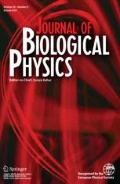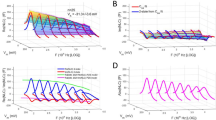Abstract
We report on the linear and nonlinear dielectric properties of budding yeast (S. cerevisiae) cells, one strain of which has been genetically modified to express prestin. This motor protein plays a crucial role in the large electromotility exhibited by the outer hair cells of mammalian inner ears. Live cell suspensions exhibit enormous dielectric responses, which can be used to probe metabolic activity, membrane potential, and other properties. The aims of this study are: (1) to compare the dielectric responses of organisms expressing prestin from those of control specimens, and (2) ultimately to further develop dielectric response as a tool to study live cells, proteins, and lipids.
Similar content being viewed by others
References
Schwan, H.P.: Electrical Properties of Tissue and Cell Suspensions, in J.A. Lawrence and C.A. Tobias (eds.), Advances in Biological and Medical Physics, Vol. V, New York, Academic Press, 1957, pp. 147–209.
Asami, K., Hanai, T. and Koizumi, N.: Dielectric Properties of Yeast Cells: Effect of Some Ionic Detergents on the Plasma Membranes, Journal of Membrane Biology 34 (1977), 145–156.
For a recent review see Asami, K.: Characterization of Biological Cells by Dielectric Spectroscopy, J. Non-Crystalline Solids 305 (2002), 268–277.
Prodan, C. and Prodan, E.: The Dielectric Behaviour of Living Cell Suspensions, J. Phys. D: Applied Phys. 32 (1999), 335–343.
Prodan, C.: Dielectric Properties of Live Cell Suspensions, Ph.D. Dissertation, University of Houston (2003).
Prodan, C., Claycomb, J.R., Prodan, E. and Miller, J.H., Jr.: High-T c SQUID-Based Impedance Spectroscopy of Living Cells Suspensions, Physica C 341–348 (2000), 2693–2694.
Prodan, C., Mayo, F., Claycomb, J.R., Miller, J.H., Jr. and Benedik, M.J.: Low-Frequency, Low-Field Dielectric Spectroscopy of Living Cell Suspensions, J. Appl. Phys. 95 (2004), 3754–3756.
Woodward, A.M. and Kell, D.B.: On the Nonlinear Dielectric Properties of Biological Systems. Saccharomyces cerevisiae, Bioelectrochem. & Bioenerg. 24 (1990), 83–100.
Woodward, A.M. and Kell, D.B.: Dual-Frequency Excitation: A Novel Method for Probing the Nonlinear Dielectric Properties of Biological Systems, and its Application to Suspensions of S. cerevisiae, Bioelectrochem. & Bioenerg. 25 (1991), 395–413.
Jonscher, A.K.: The ‘Universal’ Dielectric Response, Nature 267 (1977), 673–679.
Raicu, V.: Dielectric Dispersion of Biological Matter: Model Combining Debye-Type and ‘Universal’ Responses, Phys. Rev. E 60 (1999), 4677–4680.
Raicu, V., Sato, T. and Raicu, G.: Non-Debye Dielectric Relaxation in Biological Structures Arises From Their Fractal Nature, Phy. Rev. E 64 (2001), 021916-1–10.
Brownell, W.E., Bader, C.R., Bertrand, D. and De Ribaupierre, Y.: Evoked Mechanical Responses of Isolated Cochlear Outer Hair Cells, Science 227 (1985), 194–196.
Kachar, B., Brownell, W.E., Altschuler, R. and Fox, J.: Electrokinetic Shape Changes of Cochlear Outer Hair Cells, Nature 322 (1986), 365–368.
Hudspeth, A.J. and Corey, D.P.: Sensitivity, Polarity, and Conductance Change in the Response of Vertebrate Hair Cells to Controlled Mechanical Stimuli, Proc. Nat. Acad. Sci. USA 74 (1977), 2407–2411.
Brownell, W.E., Spector, A.A., Raphael, R.M. and Popel, A.S.: Micro- and nanomechanics of the Cochlear Outer Hair Cells, Annu. Rev. Biomed. Eng. 3 (2001), 169–194.
Zheng, J., Shen, W., He, D.Z.Z., Long, K., Madison, L.D. and Dallos, P.: Prestin is the Motor Protein of Cochlear Outer Hair Cells, Nature 405 (2000), 149–155.
Dallos, P. and Fakler, B.: Prestin, a New Type of Motor Protein, Nature Rev.: Mol. Cell Biol. 3 (2002), 104–111.
Oliver, D., He, D.Z.Z., Klöcker, N., Ludwig, J., Schulte, U., Waldegger, S., Ruppersberg, J.P., Dallos, P. and Fakler, B.: Intracellular Anions as the Voltage-Sensor of Prestin, the Outer Hair Cell Motor Protein, Science 292 (2001), 2340–2343.
Ashmore, J.F.: Forward and Reverse Transduction in Guinea-pig Outer Hair Cells: The Cellular Basis of the Cochlear Amplifier, Neurosci. Res. Suppl. 12 (1990), S39–S50.
Santos-Sachhi, J.: Reversible Inhibition of Voltage-Dependent Outer Hair Cell Motility and Capacitance, J. Neurosci. 11 (1991), 3096–3110.
Rabbitt, R.D., Ayliffe, H.E., Christensen, D., Pamarthy, K., Durney, C., Clifford, S. and Brownell, W.E.: Evidence of Piezoelectric Resonance in Isolated Outer Hair Cells, Biophys. J. 88 (2005), 2257–2265.
Author information
Authors and Affiliations
Corresponding author
Rights and permissions
About this article
Cite this article
Miller, J.H., Nawarathna, D., Warmflash, D. et al. Dielectric Properties of Yeast Cells Expressed With the Motor Protein Prestin. J Biol Phys 31, 465–475 (2005). https://doi.org/10.1007/s10867-005-6064-6
Issue Date:
DOI: https://doi.org/10.1007/s10867-005-6064-6




